The 1990s delivered some of the most iconic automotive designs we’ve ever seen – a perfect blend of sleek curves and bold angles that defined an entire generation’s automotive dreams. From the legendary Toyota Supra’s flowing lines to the Mazda RX-7’s distinctive pop-up headlights, 90s cars possessed an unmistakable aesthetic that screams pure automotive passion.
We’re talking about an era when car manufacturers weren’t afraid to take risks with their designs. Sharp body lines met smooth surfaces while vibrant colors like Laser Red and Electric Blue dominated showrooms. These vehicles featured distinctive elements like wraparound taillights, aggressive front splitters, and those unforgettable five-spoke wheels that became synonymous with the decade.
Today’s automotive enthusiasts can’t get enough of this retro aesthetic. Whether you’re restoring a classic 90s ride or simply appreciating their timeless appeal, understanding what made these cars so visually compelling helps us recognize why they remain automotive icons decades later.
The Rise of Angular Design Language in 90s Automotive Styling
Building on the bold aesthetic revolution that began earlier in the decade, automotive designers embraced increasingly angular approaches that would define the era’s most memorable vehicles.
Sharp Lines and Geometric Forms
Straight edges became the defining characteristic of 90s automotive design, replacing the flowing contours that previously dominated showrooms. Designers at major manufacturers like BMW, Audi, and Volvo adopted crisp body creases that created dramatic shadow play across vehicle surfaces. The BMW E36 3 Series exemplified this trend with its knife-edge character lines running from headlight to taillight.
Triangular elements appeared throughout 90s car designs, from the aggressive front fascias of sports cars to the geometric taillights that became signature features. The Lamborghini Diablo showcased extreme angular treatment with its wedge profile and sharp-angled side air intakes. Similarly, the Dodge Viper’s hood featured pronounced angular vents that emphasized its aggressive personality.
Rectangular headlights replaced the round units of previous decades, giving vehicles a more modern and technical appearance. European manufacturers particularly embraced this trend, with models like the Mercedes-Benz W140 S-Class featuring perfectly rectangular headlight housings that aligned with the car’s imposing grille geometry.
Departure from 80s Rounded Curves
Aerodynamic efficiency took a backseat to bold visual impact as designers moved away from the soap bar shapes that characterized 1980s vehicles. The transition from cars like the rounded Ford Taurus to the angular Ford Contour demonstrated this dramatic shift in design philosophy. Manufacturers prioritized distinctive visual identity over pure wind tunnel optimization.
Boxy proportions returned to mainstream acceptance, particularly in luxury and performance segments where presence mattered more than fuel economy. The Volvo 850 wagon epitomized this approach with its distinctly rectangular silhouette that proudly rejected aerodynamic compromises. Similarly, the BMW E34 5 Series featured pronounced shoulders and flat surfaces that created an imposing road presence.
Hard edges replaced the soft transitions that defined 80s automotive styling, creating vehicles with more defined personalities and stronger visual hierarchies. The Nissan 300ZX transformation from its curvy predecessor to the sharp-edged Z32 generation perfectly illustrated this industry-wide movement toward more aggressive geometric forms.
Iconic 90s Sports Cars That Defined the Decade’s Visual Identity
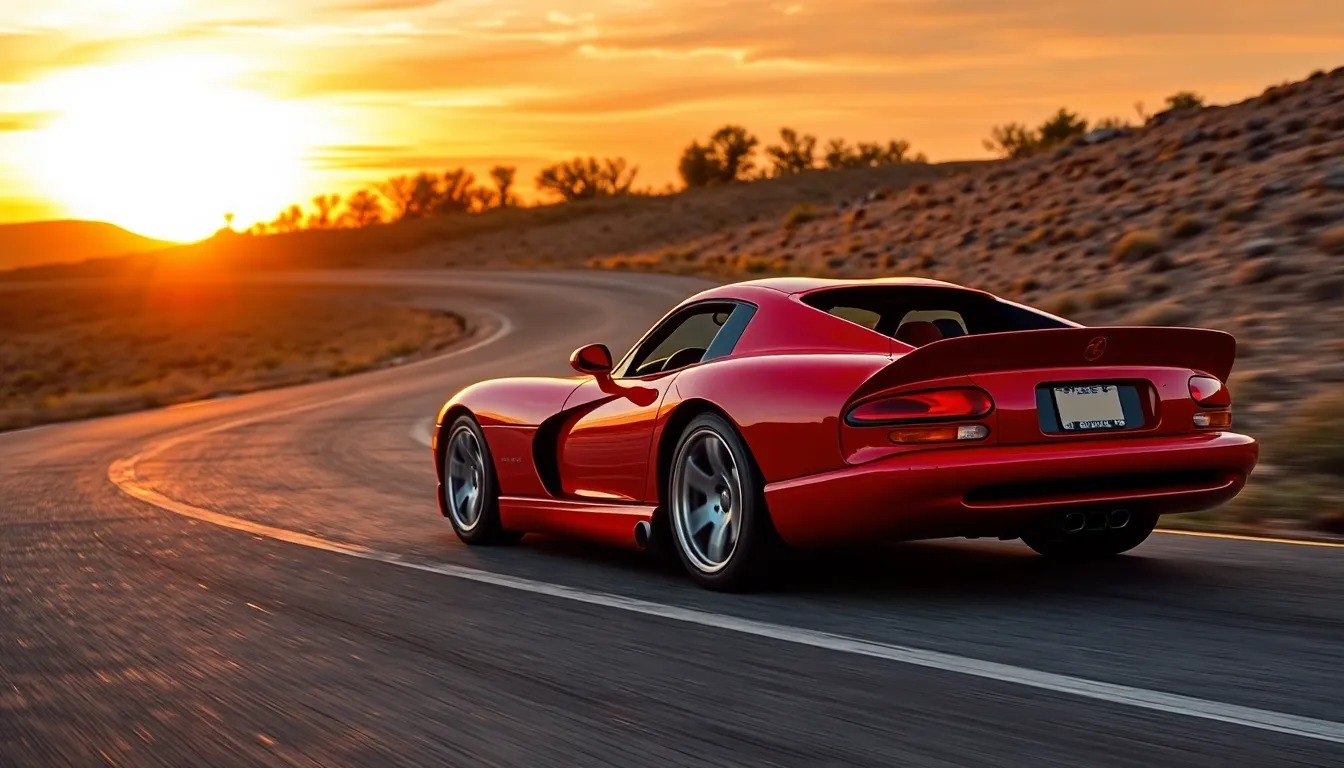
These legendary performance machines transformed automotive design language and established visual benchmarks that continue influencing modern sports car aesthetics.
Toyota Supra MK4’s Aggressive Stance
Toyota Supra MK4 revolutionized sports car design with its distinctive bulging fender flares and muscular rear haunches that projected power even while stationary. Wide body proportions created an intimidating road presence that emphasized the car’s twin turbo performance capabilities beneath the hood. Angular headlight housings replaced softer curves from earlier generations, featuring sharp cutlines that complemented the car’s aggressive front splitter design.
Aerodynamic elements like the prominent rear spoiler and side air intakes weren’t merely decorative but served functional purposes while improving the Supra’s menacing appearance. Clean body lines flowed seamlessly from the front bumper to the rear diffuser, creating visual continuity that made the car appear longer and lower than its actual dimensions. Bold color options including Renaissance Red and Quicksilver Metallic amplified the Supra’s commanding street presence and photogenic qualities.
Nissan 300ZX’s Sleek Silhouette
Nissan 300ZX showcased sophisticated design elegance through its flowing roofline and carefully sculpted body panels that balanced aggression with refinement. Smooth curves dominated the car’s profile, creating a visual flow that emphasized speed and aerodynamic efficiency over brute force aesthetics. Distinctive T top configuration offered open air driving while maintaining structural integrity and visual appeal of the coupe’s sleek proportions.
Pop up headlights became the 300ZX’s signature design element, providing a clean nose profile during daylight hours and dramatic lighting reveal after dark. Side vents behind the doors served both cooling functions and visual breaks in the car’s otherwise uninterrupted body lines. Rear hatch glass integrated seamlessly with the spoiler design, creating a cohesive tail section that appeared both modern and timeless.
Dodge Viper’s Raw Muscular Appeal
Dodge Viper embodied American automotive excess through its exaggerated proportions and unapologetically brutal design philosophy that prioritized visual impact over subtlety. Massive hood dominated the car’s front profile, housing the legendary V10 engine while creating an intimidating presence that communicated raw power to onlookers. Side exhaust pipes emerged dramatically from behind the front wheels, adding both visual drama and an unmistakable soundtrack to the driving experience.
Minimal body cladding and sparse interior appointments reinforced the Viper’s no nonsense performance mission while creating a purposeful aesthetic that appealed to driving purists. Wide rear fenders accommodated massive tires that filled the wheel wells completely, emphasizing the car’s track focused capabilities. Bright exterior colors like Viper Red and Competition Blue enhanced the car’s aggressive stance and ensured maximum visual impact in any setting.
The Influence of Japanese Design Philosophy on 90s Cars Aesthetic
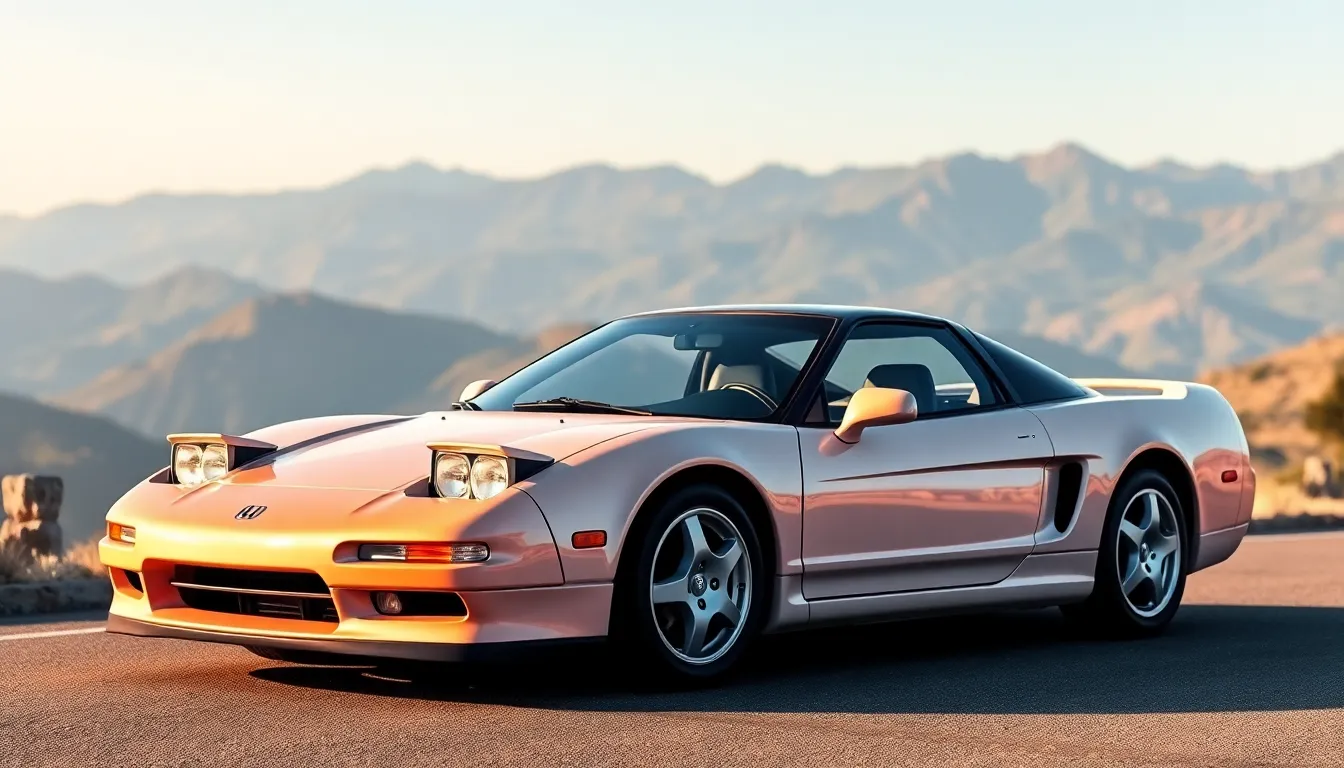
Japanese automakers introduced a revolutionary approach to automotive design that balanced efficiency with emotion during the 1990s. This philosophy transformed how we perceive functional beauty in car design.
Minimalist Interior Approaches
Japanese manufacturers embraced clean lines and uncluttered dashboard layouts that prioritized driver focus over excessive ornamentation. Honda’s Civic and Accord featured simple gauge clusters with clear white backgrounds and black numerals that eliminated visual noise. Toyota’s Camry interior showcased smooth surfaces with subtle textures that created a calming environment without distracting elements.
Nissan’s 240SX demonstrated how Japanese designers used negative space effectively by positioning controls logically within easy reach. Mazda’s MX-5 Miata interior epitomized the “less is more” philosophy with its straightforward layout that kept drivers connected to the driving experience. Lexus elevated this approach in their LS 400 by combining minimalist aesthetics with premium materials like genuine wood trim and supple leather.
Storage answers reflected practical thinking through hidden compartments and multi-purpose cup holders that maintained clean sightlines. Button placement followed ergonomic principles rather than decorative arrangements seen in European luxury cars of the era. Color palettes typically featured neutral tones like charcoal gray and beige that aged gracefully over time.
Functional Beauty Over Ornate Details
Performance enhancement drove every design decision in Japanese sports cars without sacrificing visual appeal. The Honda NSX featured aerodynamic elements that served dual purposes as both functional air management tools and striking visual accents. Subaru’s Impreza WRX showcased how hood scoops and side vents could appear aggressive while improving engine cooling and performance.
Manufacturing efficiency influenced exterior design choices that reduced production costs while maintaining distinctive character. Simple body panel stamping created sharp creases on models like the Nissan Sentra SE-R that looked expensive without complex tooling requirements. Paint schemes often featured solid colors that highlighted the car’s natural proportions rather than hiding them behind busy graphics or trim pieces.
Wheel designs reflected this philosophy through five-spoke patterns and clean hub designs that emphasized strength over decoration. Interior switches and knobs featured tactile feedback that prioritized usability during spirited driving sessions. Even luxury features like automatic climate control systems used straightforward interfaces that drivers could operate without taking their eyes off the road for extended periods.
Bold Color Combinations That Screamed 90s Automotive Style

Color choices defined the visual rebellion of 90s automotive design as much as angular lines and aggressive styling cues. Manufacturers embraced vibrant metallics and unconventional finishes that transformed ordinary vehicles into rolling statements of personality.
Electric Blue and Teal Metallics
Electric blue dominated the 90s automotive color palette with its striking metallic finish that caught light from every angle. We saw this bold choice across multiple segments, from the Ford Escort GT’s brilliant blue to the Subaru Impreza WRX’s iconic Industry Rally Blue Pearl. Teal metallics offered a sophisticated alternative that balanced green and blue undertones, creating depth that shifted with lighting conditions.
Acura’s Electron Blue Pearl became synonymous with performance models like the Integra Type R, while Mazda’s Laguna Blue Mica adorned countless MX-5 Miatas cruising coastal highways. These colors weren’t just paint options but identity markers that separated 90s cars from their conservative predecessors. The metallic particles embedded in these finishes created a three-dimensional effect that emphasized every curve and crease.
Plymouth’s Intense Blue Pearl and Nissan’s Electric Blue Metallic pushed boundaries even further, offering almost supernatural vibrancy that demanded attention in parking lots and showrooms alike.
Deep Purple and Burgundy Finishes
Deep purple emerged as the luxury color choice of the decade, with manufacturers like Chrysler leading the charge with their Plum Crazy and Deep Amethyst Pearl options. We witnessed this trend across premium models, where rich purple metallics conveyed sophistication without sacrificing boldness. Burgundy finishes complemented this palette, offering wine-inspired tones that appealed to buyers seeking elegance with edge.
Ford’s Deep Violet Pearl graced Mustang GTs and Thunderbirds, creating a mysterious presence that shifted between purple and black depending on ambient lighting. BMW’s Techno Violet became legendary among enthusiasts, appearing on limited-edition M3s and creating instant collectibility. These darker metallics required precise application techniques to achieve their signature depth.
Pontiac’s Dark Cherry Metallic and Oldsmobile’s Dark Cherry represented the burgundy spectrum, providing rich alternatives to traditional red that photographed beautifully in automotive magazines and marketing materials.
Neon Accent Packages
Neon accent packages transformed conservative color schemes into eye-catching combinations that perfectly captured 90s excess. We observed manufacturers pairing bright accent colors with neutral base tones, creating two-tone effects that emphasized exact design elements. These packages typically featured contrasting door handles, mirror caps, and bumper inserts in vibrant yellows, oranges, and greens.
Dodge’s Neon models literally embodied this trend with their Nitro Yellow Green and Flame Red accent options that highlighted the car’s youthful character. Saturn’s plastic body panels provided the perfect canvas for experimental color blocking, with bright accent pieces that could be easily replaced or customized. These combinations often extended to interior elements, with matching seat trim and dashboard accents creating cohesive design themes.
Geo’s Metro and Tracker models featured some of the most adventurous neon combinations, including electric lime accents on black bodies and hot pink trim pieces that pushed conventional automotive aesthetics to their limits.
Distinctive Wheel and Body Kit Trends of the 90s Era
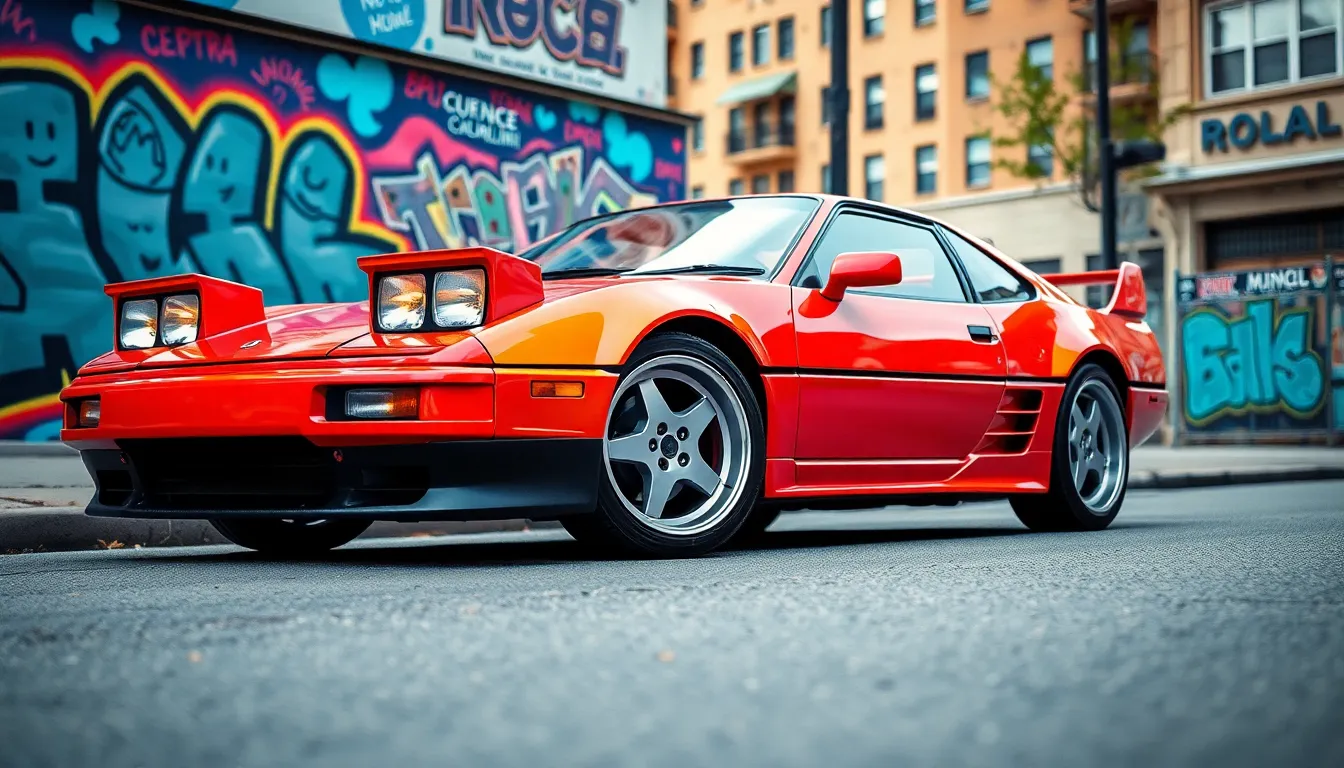
Building on the vibrant color palettes and Japanese design influences, we see wheel designs and aerodynamic enhancements becoming crucial elements that defined 90s automotive character.
Five-Spoke Alloy Wheel Popularity
Five-spoke alloy wheels dominated the 90s industry as manufacturers embraced this iconic design pattern across performance and mainstream models. Sports cars like the Toyota Supra MK4 and Mazda RX-7 featured these lightweight aluminum wheels that perfectly complemented their angular body lines. BMW’s iconic Style 5 wheels became synonymous with the E36 3 Series, while Honda’s NSX showcased how five-spoke designs could enhance both visual appeal and performance capabilities.
Lightweight construction revolutionized handling dynamics as manufacturers replaced heavy steel wheels with aluminum alloy alternatives. Performance enthusiasts gravitated toward brands like BBS, Enkei, and OZ Racing that offered aftermarket five-spoke designs in various finishes. Chrome and polished aluminum surfaces reflected the era’s preference for bright metallic accents that matched the period’s bold color choices.
Ground Effects and Side Skirt Integration
Ground effects packages transformed ordinary vehicles into aggressive street machines that captured the decade’s performance obsession. Factory body kits appeared on models ranging from the Honda Civic Si to the Ford Mustang Cobra, featuring deep front air dams and sculptural side skirts. Japanese manufacturers led this trend with cars like the Mitsubishi Eclipse GSX and Nissan 240SX showcasing how aerodynamic enhancements could create distinctive visual identities.
Side skirt integration became an art form as designers balanced functional airflow management with dramatic visual presence. Aftermarket companies like Wings West and Bomex offered extensive body kit options that allowed owners to personalize their vehicles beyond factory specifications. These modifications often featured contrasting colors or textures that emphasized the aggressive stance popular during this era.
Pop-Up Headlight Fascination
Pop-up headlights represented the pinnacle of 90s automotive drama as manufacturers used these mechanical marvels to create unforgettable front-end designs. Iconic models like the Mazda RX-7 FD and Honda NSX featured sleek profiles that transformed dramatically when headlights emerged from their hidden positions. Chevrolet’s Corvette C4 continued this tradition while the Ferrari F355 elevated pop-up headlights to exotic car status.
Engineering complexity made these systems fascinating to enthusiasts who appreciated the mechanical precision required for smooth operation. Sports car manufacturers embraced pop-up headlights as design elements that allowed for extremely low hood lines and aggressive front fascias. The satisfying mechanical whir of motors raising and lowering these lights became an auditory signature that defined the driving experience of many 90s performance vehicles.
Interior Design Elements That Captured 90s Cars Aesthetic
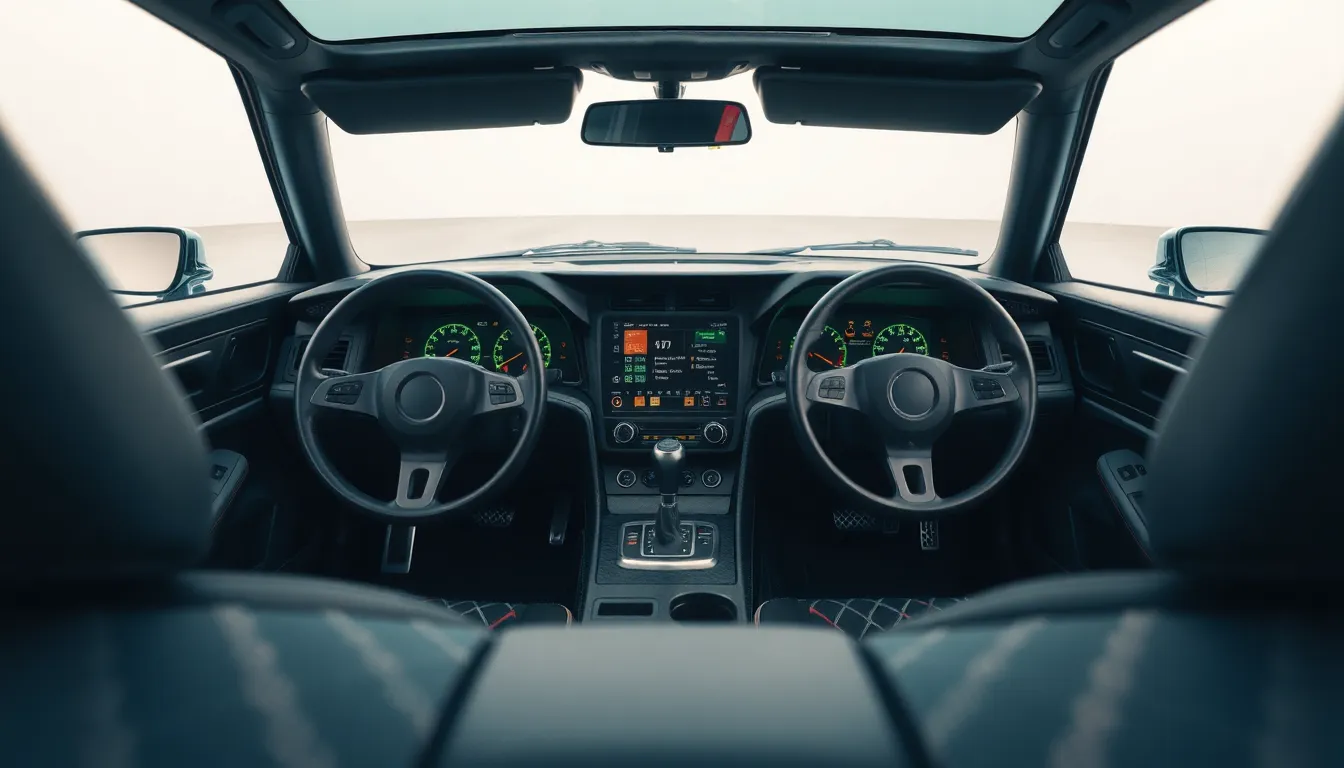
Interior designers transformed automotive cabins during the 1990s with revolutionary approaches that mirrored the bold exterior styling trends. We witnessed an era where technology met artistry inside vehicles, creating distinctive environments that perfectly captured the decade’s futuristic optimism.
Digital Dashboard Displays
Digital instrument clusters revolutionized how we experienced automotive information systems throughout the 1990s. Manufacturers like Oldsmobile pioneered fully electronic dashboard displays in vehicles such as the Cutlass Supreme, featuring bright green and amber LCD readouts that replaced traditional analog gauges. We observed how these digital systems created a spaceship-like atmosphere that perfectly matched the era’s fascination with technology and progress.
Buick’s Electra and Park Avenue models showcased comprehensive digital displays that included trip computers, fuel economy calculations, and diagnostic information systems. These early implementations used distinctive fonts and graphics that became synonymous with 90s automotive design. We noticed how the angular typography and pixelated graphics created a unique visual identity that distinguished these vehicles from their analog predecessors.
Sports cars embraced digital displays with particular enthusiasm, incorporating boost gauges, timing systems, and performance monitoring features. The Mitsubishi 3000GT and Dodge Stealth featured sophisticated electronic instrument panels that displayed critical performance data through colorful LCD screens. We can see how these digital elements enhanced the high-tech image that manufacturers cultivated during this groundbreaking decade.
Geometric Pattern Upholstery
Fabric designers embraced bold geometric patterns that transformed automotive seating into striking visual statements throughout the 1990s. We discovered how manufacturers moved away from conservative solid colors and simple textures, instead incorporating abstract shapes, angular designs, and complex weaving patterns. Models like the Pontiac Grand Am featured distinctive diamond-shaped fabric inserts that created ever-changing visual interest across seat surfaces.
Volkswagen’s Golf and Jetta models showcased plaid and checkered upholstery patterns that became iconic representations of 90s automotive interior design. These geometric arrangements used contrasting colors like black and gray, red and black, or blue and gray to create eye-catching combinations. We observed how these bold textile choices reflected the decade’s broader design philosophy of mixing traditional elements with contemporary flair.
Luxury vehicles incorporated more sophisticated geometric patterns through premium materials like embossed leather and woven fabric combinations. BMW’s E36 3 Series offered optional geometric leather patterns that featured raised diamond quilting and angular stitching designs. We noticed how these upscale treatments maintained the era’s geometric aesthetic while elevating material quality and craftsmanship.
Driver-Focused Cockpit Layouts
Automotive designers prioritized driver-centric cabin arrangements that enhanced control and engagement during the 1990s. We witnessed the emergence of wraparound dashboard designs that positioned controls and displays within easy reach of the driver’s position. The Chevrolet Corvette C4 exemplified this philosophy with its angled center console and instrument panel that created a cockpit-like environment reminiscent of fighter aircraft.
Japanese manufacturers perfected minimalist driver-focused layouts that eliminated unnecessary elements while maximizing functional efficiency. The Honda S2000 and Mazda MX-5 Miata featured streamlined cockpits where every control served a exact purpose and occupied an optimal position. We can observe how these designs reduced driver distraction while maintaining the clean aesthetic principles that defined Japanese automotive philosophy.
European luxury brands developed sophisticated driver-oriented interiors that combined ergonomic excellence with premium materials and advanced technology. BMW’s driver-focused cockpit design became a benchmark during this era, featuring angled dashboards, perfectly positioned controls, and instrument clusters optimized for driver visibility. We noted how these layouts established design principles that continue influencing modern automotive interior architecture today.
The Impact of Pop Culture on 90s Automotive Visual Trends
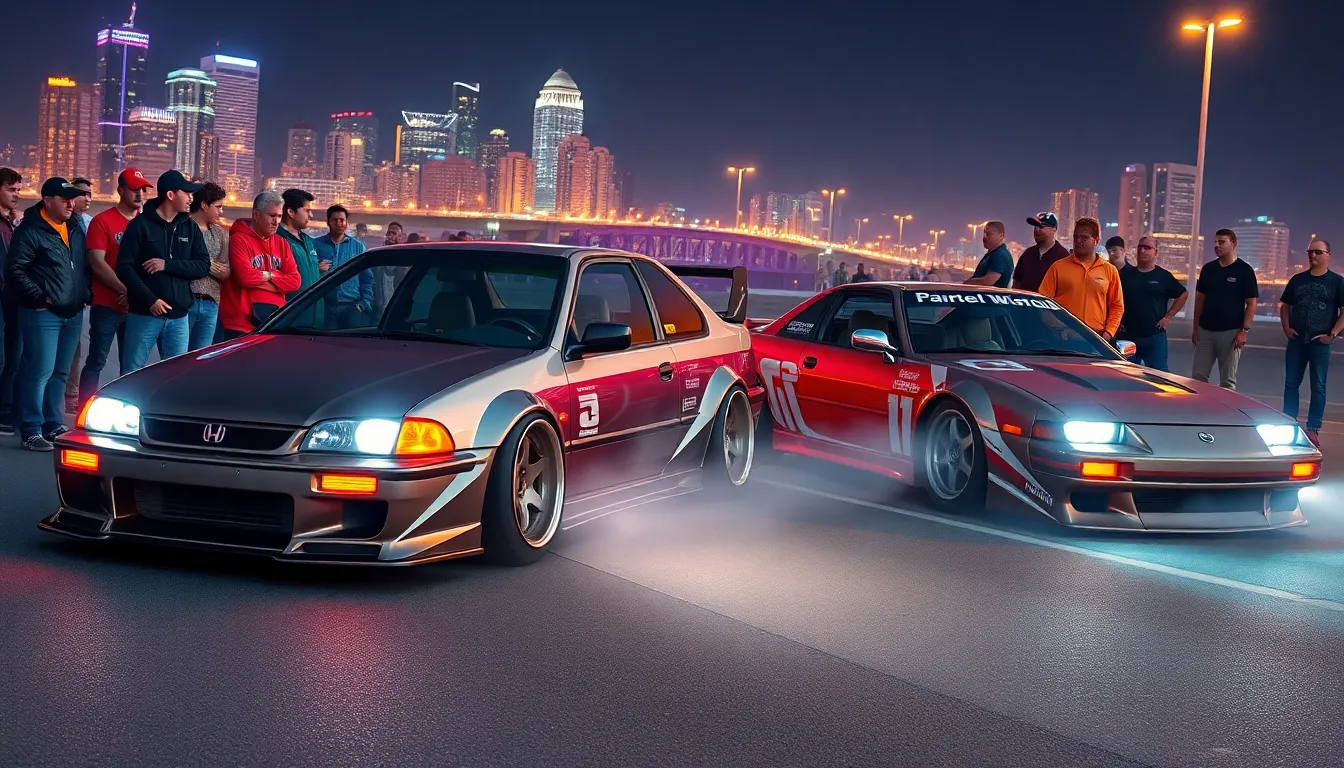
Pop culture became the driving force behind many automotive design decisions during the 1990s. Entertainment media transformed how we perceived cars, elevating them from mere transportation to cultural symbols that reflected our aspirations and identities.
Movie Car Influences
Movies delivered some of the most memorable automotive moments that shaped public perception of 90s car aesthetics. Action films like “Point Break” showcased the Porsche 911 Turbo and Ferrari F40, establishing these supercars as symbols of rebellious sophistication and dangerous allure. The Fast and Furious franchise, which debuted in 2001 but celebrated 90s tuner culture, immortalized vehicles like the Toyota Supra MK4 and Mitsubishi Eclipse GSX with their aggressive body kits and neon underglow systems.
Hollywood productions transformed ordinary vehicles into automotive icons through strategic styling choices. Films like “Rush Hour” elevated the Mitsubishi 3000GT VR-4 beyond its production numbers, making its distinctive twin-turbo setup and active aerodynamics desirable among enthusiasts. Science fiction movies pushed manufacturers to experiment with angular designs and digital displays, influencing real-industry production cars like the Pontiac Grand Prix and its futuristic dashboard layout.
Blockbuster releases created demand for exact visual modifications that became mainstream trends. Movies featuring chase sequences popularized ground effects packages, oversized rear spoilers, and performance wheel designs that filtered into everyday automotive culture. These cinematic influences convinced manufacturers that emotional appeal could drive sales just as effectively as technical specifications.
Music Video Aesthetics
Music videos transformed cars into artistic statements that reflected the decade’s bold visual culture. Hip-hop artists showcased luxury vehicles like the BMW 7 Series and Mercedes-Benz S-Class with custom paint jobs, chrome accents, and oversized wheels that became status symbols in urban communities. MTV’s constant rotation of these videos made automotive customization mainstream, inspiring countless enthusiasts to modify their own vehicles.
Electronic dance music videos embraced the neon-soaked aesthetic that defined 90s car culture. Artists featured vehicles with underglow lighting systems, custom graphics packages, and metallic paint finishes that complemented the decade’s club scene atmosphere. These visual elements became so popular that manufacturers like Dodge incorporated similar styling cues into production models like the Neon ACR.
Rock and alternative music videos celebrated the raw, unpolished automotive aesthetic that resonated with Generation X values. Bands featured muscle cars like the Dodge Viper and Chevrolet Camaro Z28, emphasizing their aggressive styling and performance capabilities over luxury appointments. This influence helped maintain demand for American performance vehicles during a period when Japanese imports dominated sales charts.
Street Racing Scene Styling
Street racing culture emerged as a powerful influence on 90s automotive aesthetics, creating a grassroots movement that manufacturers couldn’t ignore. Underground racing events popularized exact visual modifications like fender flares, hood scoops, and lightweight racing wheels that eventually appeared on factory performance models. Import tuning shops in California and New York became epicenters of innovation, developing styling trends that spread nationwide through enthusiast magazines and events.
Tuner culture elevated Japanese sports cars like the Honda Civic Si and Nissan 240SX into canvas for personal expression. Racers added custom body kits, lowered suspension systems, and performance exhaust tips that created distinctive visual signatures for their vehicles. These modifications weren’t just aesthetic choices but functional improvements that enhanced aerodynamics and cooling performance during competitive events.
Racing team sponsorships introduced professional graphics and livery designs to street-driven vehicles. Companies like Spoon Sports, Mugen, and HKS developed recognizable visual identities that enthusiasts replicated on their own cars, creating a connection between grassroots racing and commercial automotive culture. This trend influenced manufacturers to offer factory graphics packages and performance appearance options on models like the Subaru Impreza WRX and Mitsubishi Lancer Evolution.
Modern Revival of 90s Cars Aesthetic in Contemporary Design
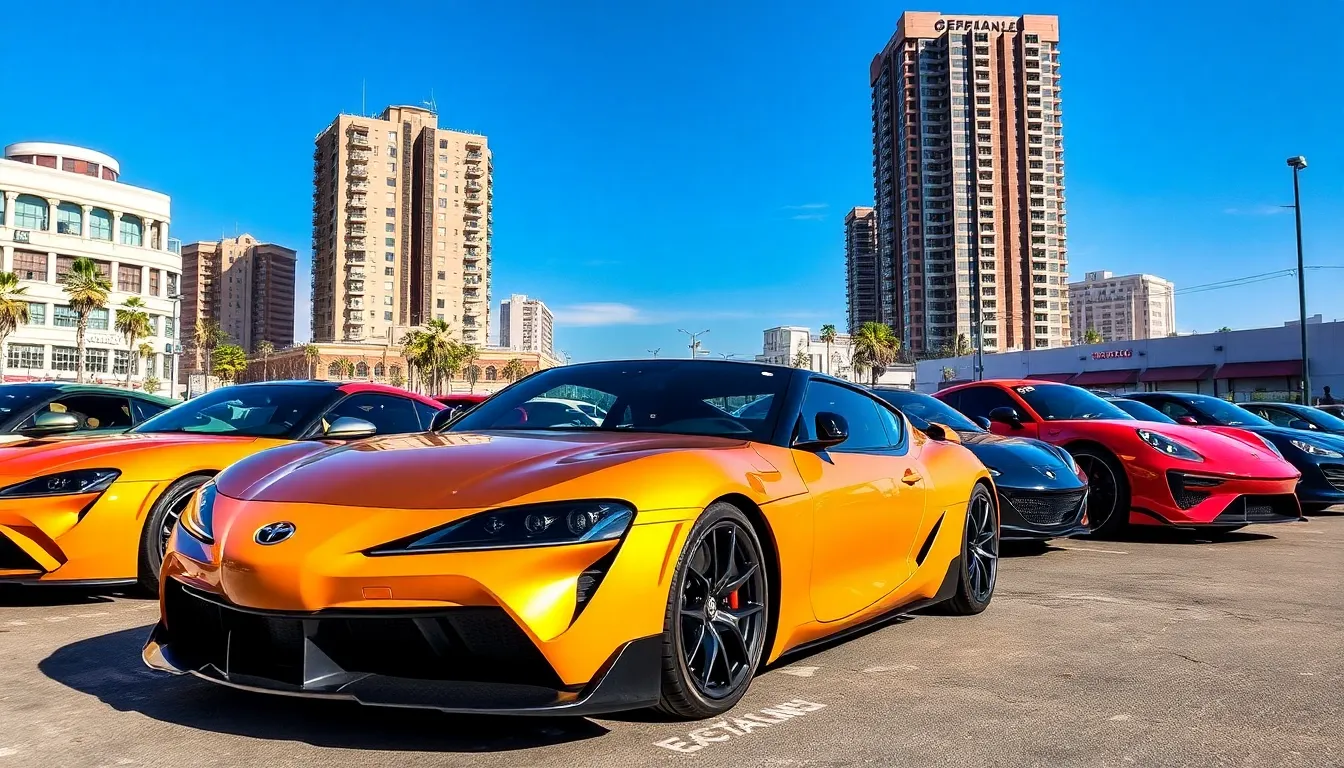
The 90s automotive aesthetic has experienced a remarkable renaissance in today’s automotive industry. Contemporary designers are drawing inspiration from the bold styling cues that defined the decade.
Retro-Inspired Concept Cars
Concept cars now showcase explicit 90s design DNA through carefully crafted homages to the era’s most beloved models. The Toyota GR Supra Heritage Edition reimagines the MK4’s aggressive stance with modern proportions while maintaining the original’s bulging fender flares. Mazda’s RX-Vision concept directly references the FD RX-7’s flowing curves and dramatic side vents, updating the silhouette with contemporary LED lighting technology.
Hyundai’s N Vision 74 concept demonstrates how manufacturers blend retro angular geometry with current safety standards. Sharp body creases reminiscent of BMW’s E36 3 Series appear throughout the design language. Pop-up headlight mechanisms have evolved into retractable LED units that preserve the mechanical drama while meeting modern regulations.
Genesis has introduced the X concept series featuring five-spoke wheel designs that echo the performance-oriented aesthetics of 90s sports cars. Electric powertrains now occupy the space where turbocharged engines once resided, yet the visual impact remains unchanged. These concepts prove that 90s styling elements can enhance rather than compromise modern vehicle architecture.
Nostalgic Design Cues in New Models
Production vehicles incorporate subtle 90s references through exact design elements that resonate with enthusiasts while appealing to contemporary buyers. The new Nissan Z features rectangular LED headlights that directly reference the 300ZX’s distinctive front-end treatment. Side profile sculpting mirrors the flowing curves that made the original Z32 generation iconic.
Honda’s Civic Type R embraces the aggressive ground effects packages that defined 90s performance cars. Functional air intakes and side skirts create the same visual drama found on models like the Subaru Impreza WRX. Interior layouts emphasize driver-focused cockpit designs with digital displays arranged in geometric patterns reminiscent of the era.
BMW’s latest M models feature color options including electric blue and teal metallics that directly recall 90s paint schemes. The iX xDrive50 offers vibrant exterior finishes previously reserved for concept cars. Mercedes-AMG has reintroduced neon accent packages through customizable LED lighting systems that transform conservative color schemes into eye-catching combinations.
Dodge continues the Viper’s legacy through the Challenger SRT series, maintaining exaggerated proportions and muscular design language. These modern interpretations prove that 90s automotive character translates effectively into contemporary vehicle platforms while meeting current safety and efficiency requirements.
Conclusion
The legacy of 90s automotive design continues to captivate us decades later proving that true style transcends time. We’re witnessing a renaissance where modern manufacturers carefully weave these nostalgic elements into contemporary vehicles creating bridges between past and present.
What makes 90s car aesthetic so enduring isn’t just nostalgia—it’s the fearless creativity that defined an entire generation of automotive design. From angular body lines to vibrant color palettes these vehicles embodied a confidence that modern cars are rediscovering.
As we look toward the future of automotive design we can’t help but appreciate how the 90s established visual languages that continue to influence today’s most compelling vehicles. The decade’s bold design philosophy reminds us that cars can be both functional machines and emotional statements that capture the spirit of their time.
Frequently Asked Questions
What defined the automotive design aesthetic of the 1990s?
The 1990s automotive design was characterized by a bold blend of sleek curves and sharp angles, moving away from the purely aerodynamic focus of the 1980s. Manufacturers embraced angular approaches with crisp body creases, rectangular headlights, and geometric forms. This era prioritized distinctive visual identity and stronger vehicle personalities over pure efficiency, creating memorable designs that combined both aggressive styling and elegant flowing lines.
Which sports cars best represent 90s automotive design?
The Toyota Supra MK4, Nissan 300ZX, and Dodge Viper are prime examples of 90s sports car design. The Supra featured aggressive stance with bulging fender flares, the 300ZX showcased sleek curves with pop-up headlights, and the Viper embodied American excess with exaggerated proportions. These models established visual benchmarks that continue influencing modern sports car aesthetics today.
How did Japanese manufacturers influence 90s car design?
Japanese automakers revolutionized 90s design by balancing efficiency with emotion through minimalist interior layouts and functional beauty. Models like the Honda Civic, Mazda MX-5 Miata, and Honda NSX featured clean lines, uncluttered dashboards, and performance enhancements integrated into visual appeal. Their “less is more” philosophy emphasized usability while creating distinctive character without complex manufacturing processes.
What color trends were popular in 90s automotive design?
The 1990s embraced vibrant metallics and unconventional finishes, moving away from conservative color schemes. Electric blue and teal metallics became iconic, seen in Ford Escort GT and Subaru Impreza WRX. Deep purple and burgundy conveyed luxury, while neon accent packages created eye-catching combinations. These bold color choices served as identity markers that distinguished 90s vehicles from their predecessors.
What were the key exterior styling features of 90s cars?
Five-spoke alloy wheels became dominant, enhancing both visual appeal and performance. Ground effects packages and side skirt integration transformed vehicles into aggressive street machines. Pop-up headlights were particularly popular, contributing to dramatic front-end designs in models like the Mazda RX-7 FD and Honda NSX. These features combined to create the distinctive 90s automotive character that enthusiasts still appreciate today.
How did interior design change in 90s vehicles?
90s interiors featured revolutionary approaches with digital dashboard displays, geometric pattern upholstery, and driver-focused cockpit layouts. Manufacturers like Oldsmobile pioneered fully electronic instrument clusters creating futuristic atmospheres. Bold, eye-catching patterns replaced conservative designs, while ergonomic excellence and streamlined layouts enhanced driver engagement, mirroring the bold exterior styling of the era.
What role did pop culture play in 90s automotive trends?
Movies and music videos transformed cars into cultural symbols, with films like “Point Break” and “The Fast and Furious” elevating models such as the Porsche 911 Turbo and Toyota Supra MK4 to iconic status. Street racing culture popularized visual modifications that manufacturers later adopted. This cultural influence helped establish certain vehicles as timeless icons beyond their mechanical capabilities.
Are 90s design elements making a comeback in modern cars?
Yes, contemporary designers are drawing inspiration from 90s styling cues in current vehicles. Concept cars like the Toyota GR Supra Heritage Edition and production vehicles such as the new Nissan Z and Honda Civic Type R incorporate nostalgic design elements. This revival demonstrates that 90s automotive character continues influencing modern design while maintaining contemporary safety and efficiency standards.

